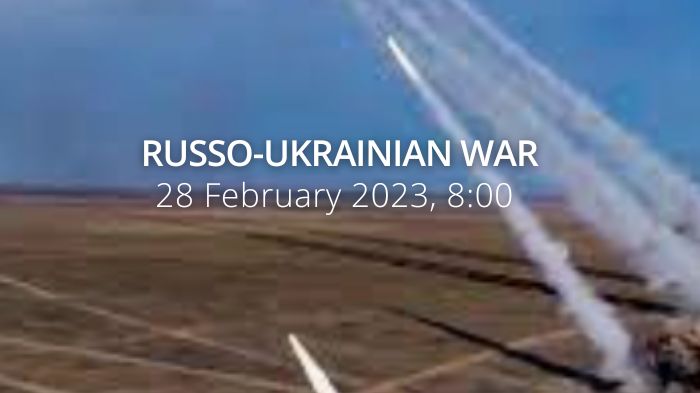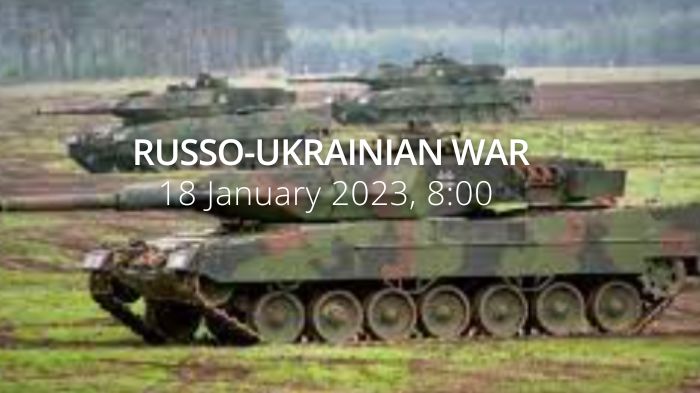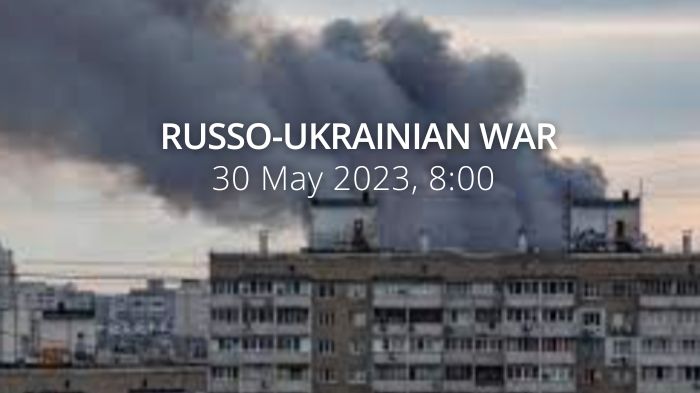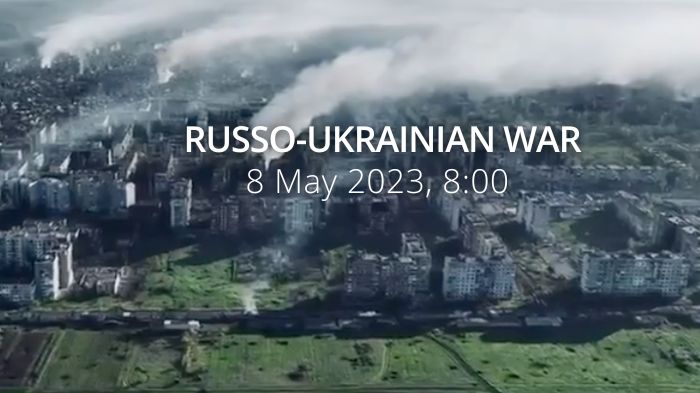Russia changes tactics of missile attacks. In Russia, military air defence forces are now subordinated to General Surovikin. The US accuses Russia of preparing to use chemical weapons in Ukraine.
https://twitter.com/EuromaidanPress/status/1630330988877209600
Daily overview — Summary report, February 28
A map of the approximate situation on the ground in Ukraine as of 00:00 UTC 28/02/23.
There have been no notable changes to control since the last update. pic.twitter.com/VQ7f2MgM4p
— War Mapper (@War_Mapper) February 28, 2023
The General Staff’s operational update regarding the Russian invasion as of 18.00 pm, February 28, 2023 is in the dropdown menu below:
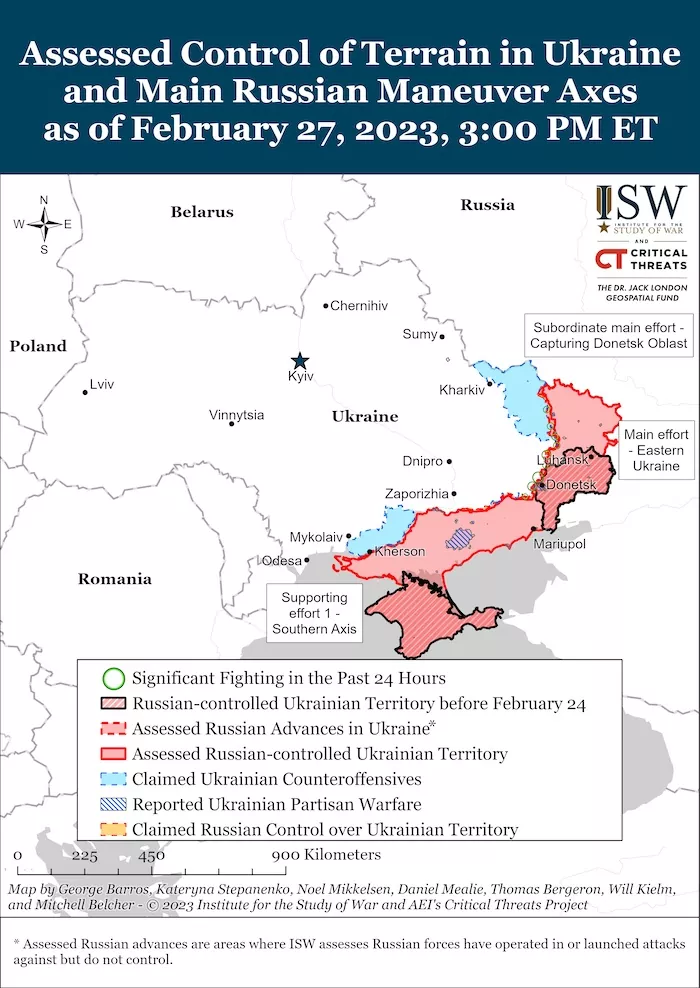
[The Russian Federation continues its full-scale armed aggression against Ukraine. The invaders’ main efforts are focused on the offensive operations on Kupiansk, Lyman, Bakhmut, Avdiivka, and Shakhtarske axes. The number of enemy personnel is increasing. According to the available information, up to 200 conscripts from Rostov oblast (Russia) have been redeployed to the temporarily occupied territory of Luhansk oblast.]
Last day, our soldiers repelled more than 60 enemy attacks in the indicated axis. At the same time, Russian forces launched 8 missiles and 32 airstrikes. Attacked 85 times from MLRS.
The threat of further missile strikes is significant throughout the territory of Ukraine.
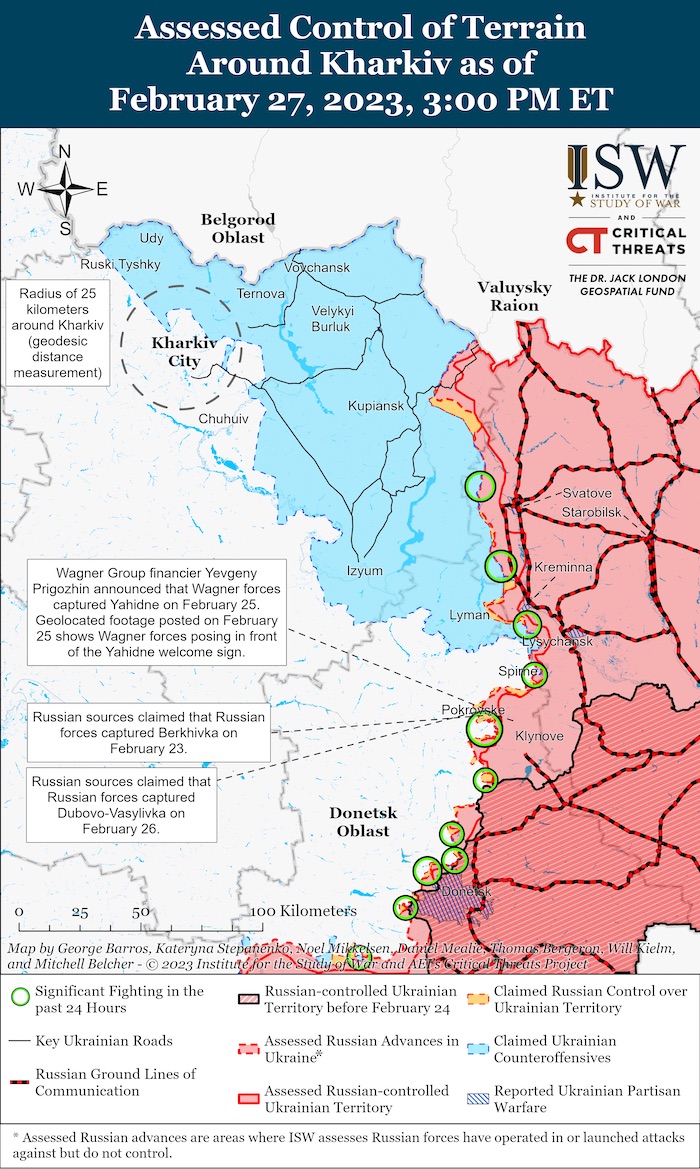
- Volyn, Polissya, Sivershchyna, and Slobozhanshchyna axes: [no significant changes, no formation of offensive groups was found. The adversary is carrying out engineering development, including anti-tank ditches, of the border areas of Bryansk and Kursk oblasts (Russia).] The occupiers shelled the settlements of Tymonovichi and Berylivka of the Chernihiv Oblast; Starykove, Brusky, Buvalyne, Kruzhok, Manukhivka, Atynske, Porozok in the Sumy Oblast and Chervona Zorya, Veterinarne, Strelecha, Gatishche, Vovchansk and Vovchanski Khutory in the Kharkiv Oblast.
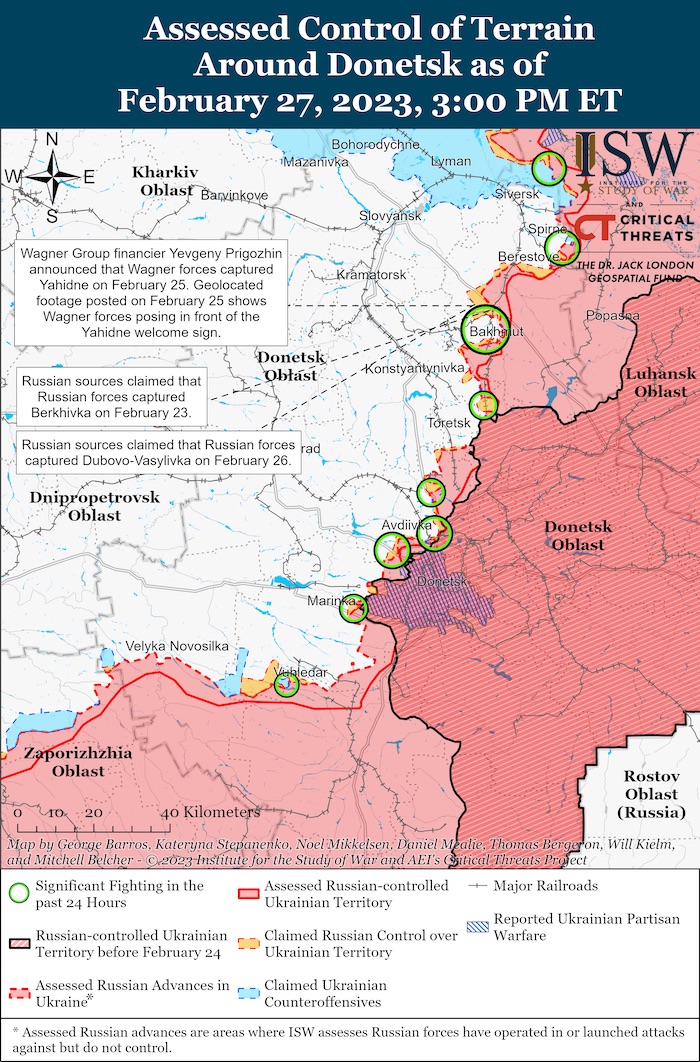
- Kupiansk and Lyman axes: the adversary carried out unsuccessful offensive actions in the areas of Makiivka, Ploshanka, Kreminna, Dibrova and Bilogorivka settlements of the Luhansk Oblast. They carried out artillery shelling in the vicinities of Dvorichna, Lyman Pershiy, Hryanikyvka, Kurylivka, Kislivka and Tabaivka settlements of the Kharkiv Oblast; Novoselivske, Nevske, Chervopopivka and Dibrova – Luhansk, Spirne and Rozdolivka in the Donetsk Oblast.
- Bakhmut axis: the Defence Forces repelled enemy attacks in the areas of Vasyukivka, Orihovo-Vasylivka, Berkhivka, Yagidne and Bakhmut settlements of the Donetsk Oblast. Zaliznyanske, Dubovo-Vasylivka, Berkhivka, Bakhmut, Ivanivske, Stupochki, Kostiantynivka, Klishchiivka, Zalizne, Ozaryanivka, Mayorsk, Pivdenne and New York were under enemy fire.
- Avdiivka and Shakhtarske axes: Russian forces continues to attack the positions of our troops and have carried out several unsuccessful offensives in the direction of Kam’ianka, Krasnohorivka, and Mar’yinka, Donetsk Oblast. They conducted artillery and mortar shelling of the areas of the settlements of Avdiivka, Lastochkine, Netaylove, Vodyane, Pervomaiske, Krasnohorivka, Nevelske, Mar’yinka, Bogoyavlenka, Novomykhailivka, Velyka Novosilka, Neskuchne, and Vugledar.
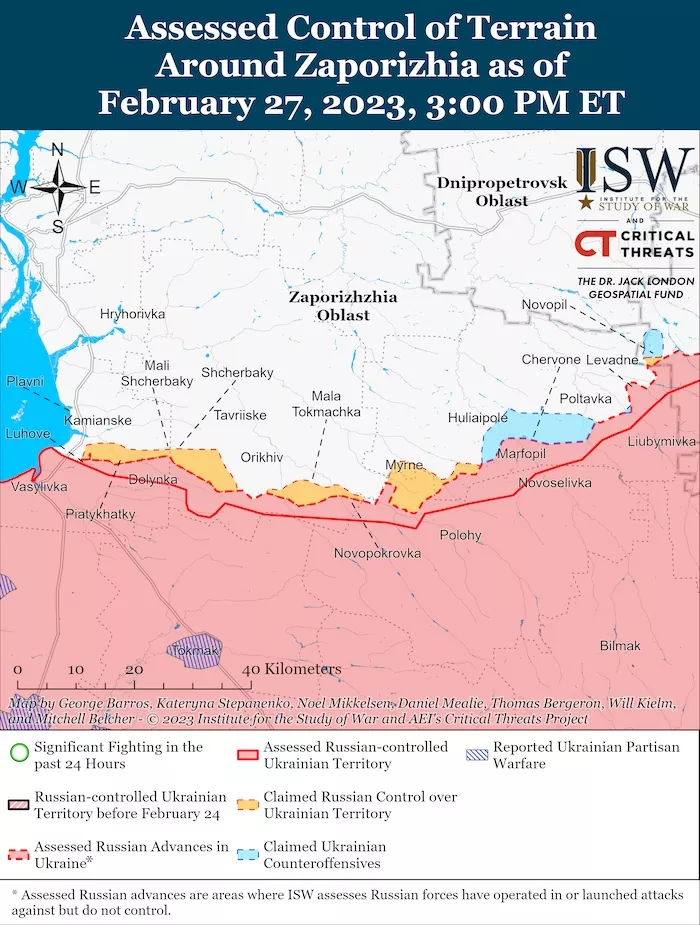
- Zaporizhzhia axis: more than 20 settlements were affected by fire. Among them are Vremivka and Novopil’ of the Donetsk Oblast; Komyshuvakha, Olhivske, Malynivka, Gulyaipole, Zaliznychne, Charivne, Orihiv and Novoandriivka of the Zaporizhzhia Oblast.
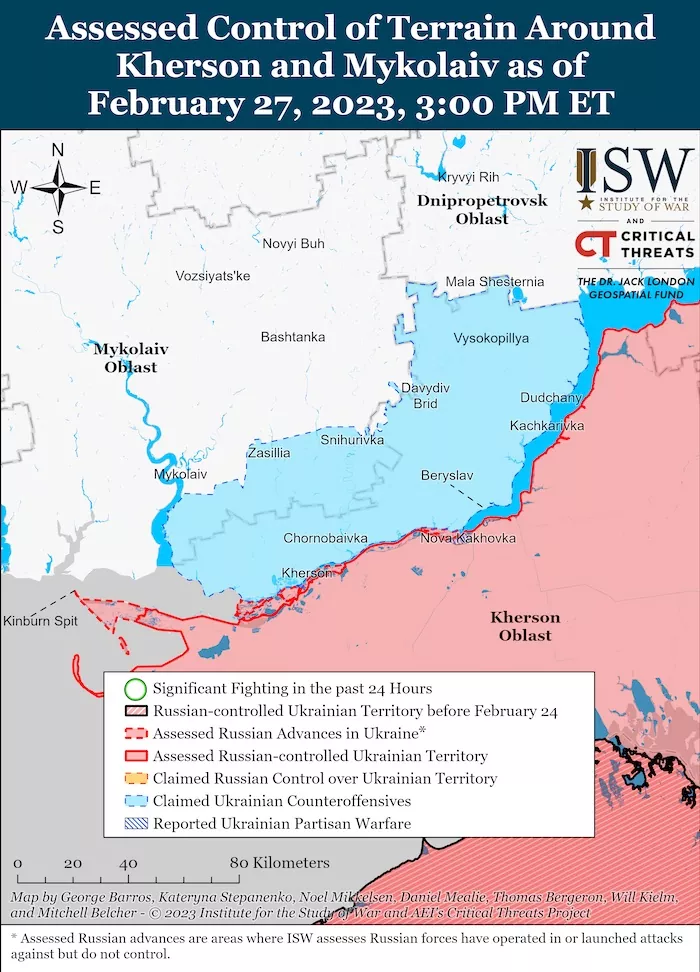
- Kherson axis: 25 settlements of the Kherson Oblast were damaged by the artillery fire of the Russian occupation forces, in particular, Havrylivka, Kachkarivka, Vesele, Tyaginka, Inzhenerne, Antonivka, Berehove and Kherson.
Russian forces are restricting the movement of the civilian population in the temporarily occupied territory of the Kherson Oblast. In particular, entry into the settlement of Promin is allowed only to citizens with local registration and with a special pass.
[The adversary continues to suffer losses. Therefore, it actively uses the local infrastructure in the temporarily occupied territories to provide medical care to its servicemen. For example, a military hospital has been set up using the facilities of a local hospital in the settlement of Kalanchak. About 150 wounded soldiers of the Russian armed forces have already been brought there. According to the available information, the medical staff are exclusively Russians.]
[Russian forces continue to act in a way to discredit the Ukrainian Defense Forces and intimidate residents of the temporarily occupied part of Kherson oblast. Yet again, Russian forces fired mortars at residential neighbourhoods of Oleshky and accused the Ukrainian Armed Forces of the shelling.]
During the past day, units of the Défense Forces destroyed 11 Iranian UAVs of the "Shaheed-136" type and 1 - of the "Zala" type.
Our aircraft made 4 strikes on areas where the occupiers were concentrated. And units of missile and artillery troops hit 1 control point, 2 areas of concentration of enemy manpower and 2 air defence positions.
Military Updates
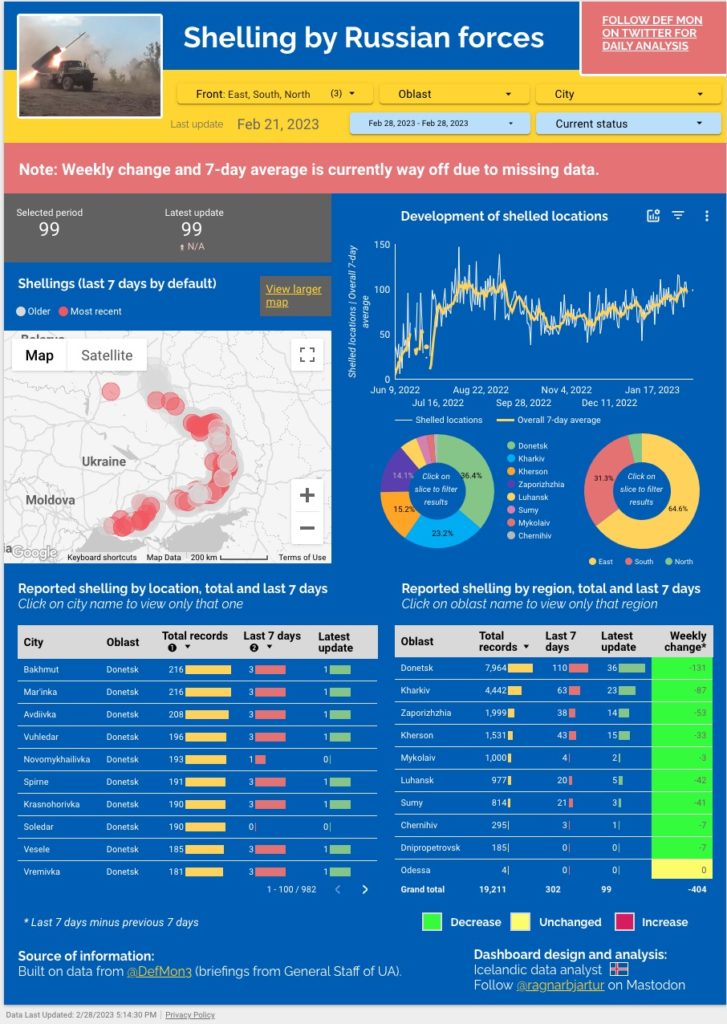
Ukrainian Air Force explains why Russians are using Shahed UAVs again, Ukrainska Pravda reports, citing Yurii Ihnat, spokesperson for the Air Force of Ukraine. "Previously, they were used more in combination with missiles. Now they are exhausting the air defence system, identifying the locations. The same A-50 radar plane takes off when we conduct combat work against the Shahed UAVs; it records the launch sites of our anti-aircraft missile systems. This way, they discover and create an algorithm of where we shoot from, how we move, etc.
Ihnat clarified that, unlike previous times, this night Russia launched Iranian drones not from the eastern coast of the Sea of Azov, but from Bryansk Oblast. Out of the 14 launched Shahed drones, 11 were shot down.”
Russia doubles the number of warships deployed off the Crimea coast, Ukrinform reports, citing Operational Command South. “Russia’s navy has doubled the number of vessels deployed in the Black Sea, including two submarine missile carriers with eight Kalibr cruise missiles on board.
The number of enemy vessels in the Black Sea has doubled. Currently, 12 ships remain at a safe distance from the Ukraine-controlled coast. Among them are two submarine missile carriers with eight Kalibrs on board and three large landing ships, the report reads.”
Ukraine vs. Russia
Overall military equipment losses by both sides after one year of Russia's all-out war against Ukraine, according to the OSINT group @oryxspioenkop pic.twitter.com/xNa5viHaoS
— Euromaidan Press (@EuromaidanPress) February 27, 2023
Putin allows Defence Ministry to reassert control over all Russian forces in Ukraine, Ukrainska Pravda reports, citing the Institute for the Study of War (ISW). "Once the bulk of the 300,000 mobilised reservists had arrived with units in Ukraine, Putin began allowing the Russian MoD to reassert its primacy over all Russian forces. Experts at the ISW have listed the number of events that indicate that Putin is likely to concentrate all Russian forces under the control of the Ministry of Defence of Russia:
- Putin namedGerasimov overall theatre commander on 11 January, subordinating Surovikin to him.
- The Russian Ministry of Defence began actively integrating the 1st and 2nd "DNR" and "LNR" army corps into the conventional Russian military and is reportedly removing proxy commanders, measures that are generating backlash within the ultranationalist community.
- The Russian Ministry of Defence is also attempting to restrict Wagner from receiving state ammunition and has stopped Wagner’s prisoner recruitment in favour of its own prisoner recruitment efforts.
- Gerasimov stripped Wagner of responsibility for Bakhmut, began introducing Russian conventional military reinforcements into the area, and ordered official Russian channels to use a euphemism for Wagner forces without using the Wagner name.
- The Russian Ministry of Defence is reportedly entertaining ideas to restrict milbloggers’ operations on the frontlines and is introducing new operational security and discipline regulations. […]
Putin’s clear efforts to prepare the Russian people for a protracted and painful war suggest that he has realised that only the Russian MoD can actually sustain the large mechanised forces he needs to have any hope of achieving his ambitions in Ukraine, the ISW summed up.”
Belarus activists say they blew up Russian military aircraft near Minsk, Reuters reports. “Belarusian anti-government activists said they had blown up a sophisticated Russian military surveillance aircraft in a drone attack at an airfield near the Belarusian capital Minsk, a claim that neither Russia nor Belarus confirmed. The plane - a Beriev A-50 aircraft - has the NATO reporting name of Mainstay and is an airborne early warning aircraft with command and control capabilities and the ability to track up to 60 targets at a time. […] They were drones (that carried out the attack). The participants of the operation are Belarusians, Aliaksandr Azarov, leader of Belarusian anti-government organization BYPOL, was quoted as saying on Sunday on the organisation's Telegram messaging app and the Poland-based Belsat news channel.”
Lukashenka convenes security forces after explosions in Machulishchy airbase, Ukrainska Pravda reports, citing Belarus-aligned news outlet BelTa and Belaruski Hajun [an independent Belarusian military monitoring media outlet]. “Aliaksandr Lukashenka […] has held a meeting with security forces following two recent explosions at a military airfield located in the village of Machulishchy. […] Lukashenka believes that the country's enemies are using every opportunity to "stir up" the situation in Belarus. […]
The meeting was attended by the Secretary of State of the Belarusian Security Council, the Ministers of Internal Affairs and Defence, and the heads of the KGB and the State Border Committee. Lukashenka himself seemed anxious.
On the morning of 26 February, the BYPOL initiative reported explosions at the Machulishchy airbase in Minsk Oblast in Belarus. There is information about a damaged Russian AWACS aircraft. Alexander Azarov, Head of the BYPOL initiative, said that Belarusian partisans were behind it. As he stated, the participants of the alleged sabotage in Machulishchy left Belarus and are now safe.”
https://twitter.com/EuromaidanPress/status/1630392090399059970
According to British Defence Intelligence, (last 48 hours):
- On 19 January 2023, amateur aircraft spotters observed a Russian A-50 MAINSTAY Airborne Early Warning (AEW) System accompanied by two MIG-31K FOXHOUND fighters departing from Machulishchy air base, Belarus. Participating in joint Russian-Belarusian air drills between 16 January and 1 February 2023.
- On 26 February 2023, Belarusian partisan group BYPOL and exiled opposition leaders reported an A-50 MAINSTAY had sustained damaged from Uncrewed Aerial Vehicle (UAV) attacks at Maschulishchy air base. BYPOL reported two explosions and damage to the front and middle sections of the A-50 MAINSTAY as well as the radar antenna.
- The A-50 MAINSTAY is a Russian airborne early warning and control platform. Its role is to build a recognised air picture and to provide coordination to adjoining fighter aircraft.
- Attribution and damage has not been officially corroborated. However, the loss of an A-50 MAINSTAY would be significant as it is critical to Russian air operations for providing an air battlespace picture. This will likely leave 6 operational A-50s in service, further constraining Russian air operations.
- Since 21 February 2023, pro-Russian officials have reported at least 14 explosions around the Russian-occupied city of Mariupol.
- Sites of the incidents have included an ammo cache at the airport, two fuel depots, and a steel works that Russia uses as a military base. Mariupol lies at least 80km away from the front line.
- Russia will likely be concerned that unexplained explosions are occurring in a zone it had probably previously assessed as beyond the range of routine Ukrainian strike capabilities. Although widely devasted earlier in the war, Mariupol is important to Russia because it is the largest city Russia captured in 2022 that it still controls, and sits on a key logistics route..
Losses of the Russian army
As of Tuesday 28 February, the approximate losses of weapons and military equipment of the Russian Armed Forces from the beginning of the invasion to the present day:
- Personnel – about 149240 (+550)
- Tanks – 3388 (+3)
- Armoured combat vehicles – 6630 (+9)
- Artillery systems – 2383 (+3)
- Multiple rocket launchers –MLRS - 478 (+3)
- Air defence means – 247 (+0)
- Aircraft - 300 (+0)
- Helicopters - 288 (+0)
- Automotive technology and fuel tanks – 5252 (+4)
- Vessels/boats - 18 (+0)
- UAV operational and tactical level – 2051 (+3)
- Special equipment – 230 (+0)
- Mobile SRBM system – 4 (+0)
- Cruise missiles – 873 (+0)
Defence Intelligence Chief believes China will not supply weapons to Russia, Ukrainska Pravda reports, citing the Head of Defence Intelligence of Ukraine, Major General Kyrylo Budanov, in an interview with Voice of America. "I do not share this opinion [that China can supply weapons to Russia – ed.]. As of now, I don't think that China will agree to the transfer of weapons to Russia. I don't see any signs that such things are even being discussed. I don't see any such facts.
According to him, almost the only country that transfers more or less serious weapons to Russia is Iran. He added that there was information about the supply from North Korea, but Ukrainian intelligence has no confirmation of this, and weapons from North Korea have never been found in Ukraine. […] Russia is just trying to buy anything anywhere. Because their problems are significant. Serbia, which everyone in Russia so hoped for, refused to transfer weapons. There are certain attempts to buy through third countries – to import weapons on a more or less large scale. Now they are trying it with Myanmar. We'll see what happens over time. But in fact, Russia is limited in the issue of weapons to, let's say, Iran."
Russia Offered to Help Iran's Missile Program in Exchange for Military Aid — CIA Director, European Pravda reports. “The United States is seeing signs that Russia is proposing to help the Iranians on their missile programme, and at least considering the possibility of providing fighter aircraft to Iran, in exchange for military aid in their ongoing invasion of Ukraine. As CNN reports, William Burns, CIA Director, said the alliance between Russia and Iran is developing rapidly, an emerging narrative that he called disturbing.
It's moving at a pretty fast clip in a very dangerous direction right now, in the sense that we know that the Iranians have already provided hundreds of armed drones to the Russians, which they're using to inflict pain on Ukrainian civilians and Ukrainian civilian infrastructure. We know that they've provided, you know, ammunition for artillery and for tanks as well, Burns said.”
Russia changes tactics of missile attacks – Defence Intelligence, Ukrainska Pravda reports, citing Defence Intelligence of Ukraine (DIU) and Andrii Cherniak, spokesperson of DIU in a commentary for RBK-Ukraine news agency. "Firstly, they are indeed learning from their mistakes. Secondly, they are running out not only of high-precision missiles but of missile armament in general. Moscow has less than 100 high-precision cruise missiles left, which are most frequently being used during the attacks – Kalibr, X-101, X-555.
Cherniak specified that, in fact, Russia still has thousands of missiles but they are using more missiles than they are manufacturing (Russians are able to manufacture not more than 30-40 missiles per month – ed.). Old missiles they have in service either do not reach their targets due to malfunctioning or have a limited damage radius.
Defence Intelligence also reports that 95% of the Russian ground forces one way or another participate in the aggression against Ukraine but do not achieve strategic success so the occupiers decided to increase their offensive potential by using aircraft more frequently.
Meanwhile, the Ukrainian air defence is being strengthened every day, and taking into consideration the fact that the Air Forces of Ukraine learned to shoot down missiles and kamikaze drones, it will be even easier to shoot down aircraft.”
In Russia, military air defence forces are now subordinated to General Surovikin – media, Ukrinform reports, citing TASS. “Military air defence forces in Russia are no longer subordinated to the ground forces command as Sergey Surovikin, chief of the Russian aerospace forces has been assigned as their new commander. Russia’s air defense forces have their own air and missile defense forces. Military air defense of the ground forces is different as it is designed to accompany and cover units in the zones of hostilities.”
Humanitarian
#Izium #massgraves and torture as ‘a microcosm of #Russia atrocities’ in occupied #Ukraine#Kharkiv #StandWithUkraine #RussiaWarCrimes #StopRussia https://t.co/fYL9JCMDaa pic.twitter.com/AfqKYRc16J
— Euromaidan Press (@EuromaidanPress) February 27, 2023
'Massive' violations in Ukraine a focus as UN human rights body meets, Reuters reports. “The UN rights chief condemned Russia's "senseless" invasion of Ukraine on Monday at the start of a Human Rights Council session at which countries want to strengthen scrutiny of Moscow's alleged war crimes […]. Volker Turk, the United Nations high commissioner, in one of his first speeches to the 47-member council, warned that human rights gains were being reined back and even reversed, citing Russia's invasion of Ukraine as an example of oppression.
UN Secretary-General Antonio Guterres said in a separate speech that the war had triggered "massive violations" of rights. During the meeting, which runs until April 4, many states will seek to extend and deepen the mandate of a UN investigation body set up to probe possible atrocities in Ukraine. Kyiv, which has called for the establishment of a special tribunal to prosecute Russia's political and military leadership over the invasion, has said the body was essential to ensure Russia is held accountable.
Several countries specifically called for the UN body to probe the alleged transfer of thousands of children from Ukraine to Russia - an act that Ukraine's foreign minister described as a "genocidal crime". […]
The Geneva-based UN Human Rights Council is the only body made up of governments to protect human rights worldwide. It does not have legally binding powers but its debates often bring heightened scrutiny to issues and it can spur investigations that feed evidence to national and international courts.”
Environmental
Over 1 million hectares of agricultural land mined in Kharkiv and Kherson oblasts, Ukrainska Pravda reports, citing Taras Vysotskyi, First Deputy Head of the Minister of Agrarian Policy and Food of Ukraine. “The situation concerning mined areas in Kharkiv and Kherson oblasts, which were occupied by Russians, remains complicated; over 1 million hectares of the territory is mined there. These territories can be divided into two types. The first one is the area where the frontline used to be, which corresponds to 80-90% of mined land.
The second type shows a lower percentage of mined land. There is a plan to sow these lands. But it is sadly impossible to sow those 200-300,000 hectares near the collision line this year, Vysotskyi explained. […]
At the moment we are witnessing a decrease in international prices of mineral fertilisers. This is the factor, which should also help us sow the territories that were not sown in autumn, in spring. We must at least sow as much land as in 2022, the Minister added.
Vysotskyi also stated that at the moment, one of the key tasks of the Ministry of Agricultural Policy and Food is to work out a mechanism of granting agricultural sector employees postponement from military conscription. We do realise that agricultural workers are in most cases also very valuable for the Armed Forces of Ukraine. It is hard, but we will need to find a compromise between facilitating the work of the agricultural sector and support of the Armed Forces of Ukraine, he summed up.”
Ukraine’s grain production cut by 37% in 2022 – UCAB, Ukrinform reports, citing Ukrainian Agribusiness Club (UCAB). “Following the results of 2022, the production output of grain crops reduced by 37% compared to the previous record-breaking results of 2021 and came to about 53.9 million tonnes, the report states. Meanwhile, Ukraine’s oilseeds production decreased by 24% to 17.5 million tonnes.
According to the UCAB, the reduction in crop production volumes was caused by several factors, namely the fact that some areas were temporarily occupied; hostilities; contamination by mines in the liberated areas; decreased yielding capacity compared to 2021; as well as the challenging and significantly extended harvesting campaign due to the rainy weather last autumn, etc.
In 2022, Ukraine’s livestock industry suffered less than crop farming but was also affected by the war, the UCAB noted. Last year the production output of all varieties of meat was reduced by 11% to 3 million tonnes compared to 2021. In addition, Ukraine produced 7.7 million tonnes of milk (-12%) and 11.6 billion eggs (-18%).
The livestock industry suffered losses for the following reasons: some production facilities were seized by Russian occupiers; some of them were destroyed or had farm animals killed during hostilities; the production chain was temporarily interrupted at the beginning of the war in the conditions of uncertainty (mostly, this refers to poultry farming), etc.
According to the UCAB, all these negative trends are the consequences of the war unleashed by Russia against Ukraine. Nevertheless, Ukraine’s agricultural sector is ready to work further to ensure food security not only for the Ukrainian people but also for the entire world, the UCAB stressed.”
Energoatom: Zaporizhzhia NPP standing idle since Sept 2022, Ukrinform reports, citing Energoatom National Nuclear Energy Generating Company of Ukraine President Petro Kotin on Suspilne TV Channel. “Since September, Zaporizhzhia NPP has been standing idle, not generating electricity but consuming 100 megawatts on a regular basis through the remaining working line. Power units 5 and 6 are now in the so-called hot position, i.e. not operating. Other power units are in a cold position, including two under repairs. The plant is serviced by the Ukrainian staff. Rosatom intervened, but their professionals do not have a license to operate power units, they have no experience, Kotin told.
In his words, Russians are continuously putting pressure on the Ukrainian personnel, forcing them to sign contracts with Rosatom. Out of 4,500 Ukrainian workers remaining at the plant, about 2,500 signed such contracts. According to Energoatom, Russian occupiers set up a maintenance depot at Zaporizhzhia NPP to repair their military equipment.”
Legal
#Russia seeks 12-year sentence against #CrimeanTatar claiming 'terrorism' in a religious discussion 7 years ago in occupied #Crimea #Ukraine #FreeAbdulvapov #FreeFevziev #LetMyPeopleGo #StandWithUkraine #StopRussiahttps://t.co/qL9ET0Tpvl pic.twitter.com/92n1y6xrSU
— Euromaidan Press (@EuromaidanPress) February 28, 2023
European Commission and Poland launch initiative of a search for Ukrainian children kidnapped by Russians, Ukrainska Pravda reports, citing European Pravda and Dana Spinant, spokesperson of the European Commission. “The European Commission, in conjunction with Poland, has launched the initiative to search for the Ukrainian children who were illegally deported from the occupied territories of Ukraine. It was estimated that since the beginning of the full-scale invasion of Ukraine, the Russian forces have sent thousands of Ukrainian children to Russia. Kidnapping of Ukrainian children is a big social issue, tragedy and crime.
This is why, in conjunction with Poland, we launch this initiative with the support of the UN agencies. Our goal is to unite the forces in order to collect evidence, find the kidnapped children and prosecute those responsible for these crimes, Spinant added.”
Yellen says legal obstacles remain on the seizure of Russian assets to aid Ukraine, Reuters reports. “US Treasury Secretary Janet Yellen said on Monday that Russia should bear the costs of damage caused by its invasion of Ukraine, but there are significant legal obstacles to confiscating major frozen Russian assets. […] Yellen said the United States and its allies were discussing strategies to ensure that Russia pays for the devastation that its war, now in its second year, with estimates in the hundreds of billions of dollars and growing every day.
Washington has confiscated assets used in criminal activity but the central bank and other large pools of assets frozen by sanctions are another matter. We have on this small scale, seized assets, but there are certainly legal challenges in doing more than that, she said.
The United States and Western allies have seized more than $300 billion in Russian central bank foreign currency assets frozen by sanctions. The assets are held abroad, with a significant portion at the Federal Reserve Bank of New York, but remain under Russian ownership.”
Support
https://twitter.com/EuromaidanPress/status/1630441415451852801
Zaluzhnyi and Milley discuss the need for strengthening Ukrainian air defence forces, Ukrinform reports. “In today’s phone call with Chairman of the US Joint Chiefs of Staff, General Milley, we traditionally paid attention to the supply of military equipment, weapons and ammunition within the international technical assistance to Ukraine, the situation on the front line and further plans of Ukraine’s Defence Forces regarding the de-occupation of Ukraine’s territory,” Zaluzhnyi wrote on Telegram.
In addition, during the conversation, the Commander-in-Chief of the Armed Forces focused on the need to strengthen Ukraine’s air defence capabilities, in particular through the supply of F16 multi-role fighter aircraft.”
Poland will send the next batch of Leopard 2A4 tanks to Ukraine within a few weeks, European Pravda reports. “As PAP agency reports, Michal Dworczyk, Chief of the Prime Minister Chancellery, shared when the next ten promised Leopard 2A4 tanks would be delivered. Soon. First, the training of Ukrainian troops should be completed since some of these tanks are currently being used there. It will last several weeks, he said.
When asked about the PT-91 tanks announced by the Prime Minister to arrive in Ukraine, he said that their transfer with the T-72 is also a matter of weeks, if not sooner. "They are practically in the process of sending. They will soon be in Ukraine, he added. Poland became the first country to have sent the first Leopard 2 tanks to Ukraine on the first anniversary of Russia's invasion of Ukraine.”
Political decisions on six out of seven types of weapons for Ukraine unblocked – Kuleba, Ukrinform reports, citing Minister for Foreign Affairs Dmytro Kuleba. “Last year, Ukraine unblocked political decisions on six out of seven types of weapons needed by the Armed Forces. Every discussion about supplying Ukraine with a new, crucial kind of weapon started with a ‘no’ and ended with a ‘yes’. In the last year, we have unlocked political decisions on six of the seven types of game-changer weapons. The only one left is combat aircraft, Kuleba tweeted.
As reported by Ukrinform, President Volodymyr Zelensky, in an address to British MPs in Westminster Hall, called on Great Britain and the international community to create an "aircraft coalition" to provide Ukraine with combat aircraft to defend against the Russian aggressor.”
US sees long-term cooperation with Ukraine based on international donor platform - Treasury Secretary, Ukrinform reports. “The United States seeks to focus on the long-term perspective of economic cooperation with Ukraine and intends to build such cooperation based on an international donor platform. That’s according to US Treasury Secretary Janet Yellen.
She recalled that, after the start of Russia's unprovoked aggression, the United States provided Ukraine with about $50 billion in security, economic, and humanitarian assistance. Yellen also noted that, despite the war, the Ukrainian government continues its fight against corruption. She welcomed the efforts undertaken by President Volodymyr Zelensky to ensure accountability and transparent management of financial resources Ukraine receives from donors.
Looking ahead, we know that Ukraine’s process of rebuilding the economy following its victory is critical to its long-term future. That’s why we’ve been strong supporters of the multi-agency donor coordination platform for Ukraine, and the US will remain by your side at every step of the way, Yellen said.
As reported earlier, Shmyhal said that the United States had agreed to allocate more than $10 billion to Ukraine by September 2023 to cover the budget deficit.
International aid allows Ukraine’s energy system to stand against Russian attacks – Galushchenko, Ukrinform reports, citing Ukrainian Energy Minister German Galushchenko. “The aid provided by international partners to Ukraine’s energy sector has allowed the Ukrainian energy system to stand against Russian attacks and stabilize performance.
First of all, I want to thank everyone for support, which is provided to us. That is not only support with money but support with equipment, all necessary high-voltage equipment, all kinds of equipment, which we received from our friends, Galushchenko said, adding that this allows Ukraine to stand against Russian terrorist attacks on its energy infrastructure.”
New Developments
https://twitter.com/EuromaidanPress/status/1630371705951584258
- The US accuses Russia of preparing to use chemical weapons in Ukraine, Reuters "Russian troops plan to use chemical weapons in the special military operation area, [former US ambassador to Russia John Sullivan said]. We regard this information as the intention of the United States and their accomplices to carry out a provocation in Ukraine using toxic chemicals, Igor Kirillov, chief of the radiation, chemical and biological defence troops of Russia's armed forces said during a briefing.”
- Russia will not resume START nuclear talks until Washington listens to Moscow, Reuters “Russia will not resume participation in the START nuclear arms reduction treaty with the United States until Washington listens to Moscow's position, Kremlin spokesman Dmitry Peskov said in remarks published on Tuesday. President Vladimir Putin last week delivered a warningto the West over the war in Ukraine and announced Russia's decision to suspend participation in the latest START treaty, after accusing the West of being directly involved in attempts to strike its strategic air bases.”
- Ukraine advisor on Beijing’s "peace plan": China yet not fully understands “Russia is gone”, Ukrinform "There is one important point in the Chinese plan – an immediate ceasefire. And this is the only effective point that exists in this plan. And this means that Russia will remain in the occupied territories, we will have a new demarcation line, and we will see a slow absorption of Ukraine. This will not be a three-day blitzkrieg, but let's say, a three-year destruction of Ukraine with the ever-growing influence of the Russian Federation... I believe that all peace plans that provide for an immediate ceasefire and preservation of the current territorial status quo are exclusively a game in favour of the Russian Federation. It's surprising to me that someone still doesn't understand this... And it's surprising to me that China still doesn't fully understand that Russia is gone, [Mykhailo Podoliak, an adviser to the head of the Ukrainian President’s Office] said.”
- Kremlin says China's Ukraine peace plan should be studied in detail, Reuters “China, which declared a "no limits" alliance with Russia shortly before Moscow sent tens of thousands of troops into Ukraine a year ago, called for a comprehensive ceasefire in Ukraine on Friday, touting its own peace plan. Kremlin spokesman Dmitry Peskov said any such initiatives that might bring peace closer were worthy of attention. We are paying a great deal of attention to the plan of our Chinese friends, Peskov told reporters on Monday. Of course, the details need to be painstakingly analysed taking into account the interests of all the different sides. This is a very long and intense process. He said Russia was continuing to prosecute what it calls its "special military operation" in Ukraine, and for now didn't see any signs suggesting a peaceful resolution could be achieved.”
- Lukashenka's visit to Beijing confirms China's course toward deeper ties with Russia – US State Department, Ukrinform “The state visit to China by Belarusian dictator Aliaksandr Lukashenka, who is considered extremely loyal to the Kremlin, is an additional confirmation of how the leadership in Beijing is trying to deepen its contacts with Russia against the background of the brutal war the latter is waging against Ukraine. US State Department spokesman Ned Price said this at a briefing in Washington, D.C., on Monday.”
- Kremlin says it is concerned by the situation in the breakaway Moldovan region, Reuters “The Kremlin said on Monday it was worried about the state of affairs in Moldova's breakaway Transdniestria region, where it said Ukraine and other European countries were stirring up the situation. […] Moldova's pro-European president, Maia Sandu, this month accused Moscow of plotting a coup, something Russia denied. […] Ukrainian President Volodymyr Zelenskyy has dismissed Moscow's assertion that Ukraine wants to take over the region, while Moldova sad there was no truth to the allegations.”
- “Aviation taboo” must be removed to have Ukrainian skies fully protected – Zelensky, Ukrinform “President Volodymyr Zelensky says in order to ensure full protection of the sky, Ukraine needs modern warplanes to be provided by partners.”
- Belgium freezes Russian assets worth EUR 58B, Ukrinform reports, citing Belgian Deputy Prime Minister - Finance Minister Vincent Van Peteghem. “The Ministry of Finance of the Kingdom of Belgium has frozen Russian assets worth EUR 58 billion, which is the highest sum among other EU countries. Additionally, the ministry blocked Russian financial transactions worth EUR 191 billion. In general, these measures affected 1,789 Russian entities and individuals who had been put on the blacklist.”
- Türkiye's NATO talks with Sweden and Finland to resume on March 9, Reuters “Turkish Foreign Minister Mevlut Cavusoglu said on Monday talks with Sweden and Finland over their NATO membership bids would resume on March 9, although he said Sweden had still not fulfilled its obligations under a memorandum signed last year. […] Sweden, Finland and Türkiye signed the memorandum on steps toward Turkish ratification at a NATO summit in Madrid in 2022."
https://twitter.com/EuromaidanPress/status/1630340500619251714
Assessment
https://www.understandingwar.org/backgrounder/russian-offensive-campaign-assessment-february-27-2023*
- On the war.
The Institute for the Study of War has made the following assessment as of February 27, 2022:
Ukrainian officials stated that Russian forces have been concentrating and escalating operations along the Luhansk Oblast frontline. Ukrainian Eastern Group of Forces Spokesperson Colonel Serhiy Cherevaty stated on February 26 that Russian forces concentrated infantry, airborne (VDV), and Luhansk People’s Republic (LNR) forces in eastern Ukraine and have attempted to use armored vehicles in combat in the past several weeks. The Ukrainian General Staff reported on February 27 that Russian forces deployed 200 conscript recruits from Rostov Oblast to Luhansk Oblast on an unspecified date. Ukrainian Luhansk Oblast Head Serhiy Haidai stated on February 27 that Russian forces have escalated operations in the Svatove, Kreminna, and Bilohorivka directions in recent weeks and have been concentrating equipment and reserves in occupied Luhansk Oblast.
Russian forces conducted limited ground attacks northwest of Svatove on February 26 and 27. The Ukrainian General Staff reported that Russian forces conducted unsuccessful offensive operations near Masyutivka (52km northwest of Svatove), Novoselivske (16km northwest of Svatove), and Stelmakhivka (17km northwest of Svatove) on February 26 and 27.
Russian forces continued ground attacks near Kreminna on February 26 and 27. The Ukrainian General Staff reported that Russian forces conducted unsuccessful offensive operations near Kreminna, northwest of Kreminna near Ploshchanka (17km northwest) and Nevske (18km northwest); west of Kreminna near Torske (14km west); southwest of Kreminna near Dibrova (6km southwest); south of Kreminna near Bilohorivka (12km south); and near the Serebrianska forest area (11km south) on February 26 and 27. Geolocated footage suggests that Russian forces have likely pushed Ukrainian forces west from the R66 near Pishchane and Chervonopopivka (5-6km northwest of Kreminna). A Russian source claimed that Ukrainian forces repelled Russian ground attacks in the Bilohorivka, Zarichne, Yampolivka, Terny, and Makiivka directions. A Kremlin-affiliated milblogger claimed that Russian forces along the Svatove-Kreminna-Bilohorivka-Lysychansk line have adopted a new approach to make gradual advances, which is consistent with reports of a new Russian maneuver element that can only advance at the pace of dismounted infantry and whose attacks will culminate quickly before securing significant gains.
Russian forces continued ground attacks around Bakhmut on February 26 and 27. The Ukrainian General Staff reported that Russian forces conducted unsuccessful attacks on Bakhmut itself; north of Bakhmut near Vasyukivka (13km north), Zaliznianske (8km north), Dubovo-Vasylivka (6km northwest), Orikhovo-Vasylivka (10km northwest), Berkhivka (4km north), Yahidne (1km northwest), and Bohdanivka (8km northwest); west of Bakhmut near Ivanivske (5km west); and southwest of Bakhmut near Stupochky (12km southwest) and Pivnichne (20km southwest) between February 26 and 27. Ukrainian Eastern Group of Forces Spokesperson Colonel Serhiy Cherevaty noted that Russian forces conducted 32 ground attacks around Bakhmut and 14 within the city on February 26. Russian sources widely claimed that Wagner Group forces made gains north of Bakhmut on both February 26 and 27. Several Russian milbloggers claimed that Wagner took control of Yahidne, advanced south of the Berkhivka reservoir, and moved westward to threaten Bohdanivka. Milbloggers claimed that Russian advances north and northwest of Bakhmut will allow Russian forces to threaten the Khromove-Bakhmut route, with several Russian milbloggers indicating that Russian troops have taken at least part of the route under fire control. Donetsk People’s Republic (DNR) advisor Igor Kimakovsky claimed that Wagner forces are moving closer to the center of Bakhmut itself, and a Russian milblogger claimed that Wagner has made gains on the eastern outskirts of Bakhmut and toward Koperatyvna Vulystia, which is near Bakhmut’s city center. Russian sources additionally claimed that Wagner continued assaults toward Ivanivske on both February 26 and 27. Former Russian officer and prominent critical milblogger Igor Girkin remarked on February 27 that current Russian assaults on Bakhmut are useless and will exhaust Russian troops without taking strategically significant ground.
Russian forces continued ground attacks in the Avdiivka-Donetsk City area on February 26 and 27. The Ukrainian General Staff reported that Russian troops conducted unsuccessful attacks north of Donetsk City near Avdiivka, Sieverne, and Kamianka, on the northwestern outskirts of Donetsk City near Vodyane, Nevelske, and Krasnohorivka, and on the southwestern outskirts of Donetsk City near Marinka. Russian sources claimed that Russian forces are expanding their zone of control northeast of Avdiivka near Novobakhmutivka, but noted that this advance is bounded by the H20 Donetsk City-Kostiantynivka highway, which Russian forces have not yet crossed. A Russian milblogger noted that the DNR’s "Somalia" battalion is moving toward Avdiivka. Russian milbloggers additionally discussed efforts of the DNR’s 5th Brigade within Marinka on February 26 and 27 and claimed that Russian troops successfully pushed Ukrainian troops out of positions in western Marinka.
Russian forces continued ground attacks in western Donetsk Oblast on February 26 and 27. The Ukrainian General Staff stated that Russian troops conducted unsuccessful offensive operations near Vuhledar (30km southwest of Donetsk City) on February 27. Geolocated footage posted on February 25 and 26 shows that Russian forces made minor advances on an unspecified date directly south of Vuhledar. Russian milbloggers continued to discuss intense positional battles in the Vuhledar area, with one source claiming that Russian naval infantry elements are fighting toward Vuhledar from Mykilske, just southeast of Vuhledar. A Russian milblogger circulated footage on February 26 of Eastern Military District (EMD) Commander Rustam Muradov and Russian Far Eastern Federal District representative Yuri Trutnev presenting naval infantry forces in the Vuhledar direction with service awards, supporting ISW’s observation that this axis is the area of responsibility of EMD and naval infantry elements. The former DNR Militia spokesperson (who was reportedly recently dismissed from his post) visited the Vuhledar area on February 26 and noted that it is important for Russian forces to defend against Ukrainian counterattacks in this area because Ukraine wants to cut Russian supply routes to occupied Crimea. Ukrainian Tavriisk Defense Group spokesperson Colonel Oleksiy Dmytrashkivskyi noted that the pace of Russian operations in the Vuhledar area has overall decreased over the past four days due to poor weather and noted that Russian forces only conducted 17 ground attacks near Vuhledar on February 27.
Russian officials are promoting an information operation that falsely frames Russia’s war in Ukraine as existential to the continued existence of the Russian Federation. In an interview with TV channel Rossiya-1 on February 26, Russian President Vladimir Putin warned that he does not know if "such an ethnic group as the Russian people can survive in the form in which it exists today" if the West succeeds in "destroying the Russian Federation and establishing control over its fragments." Putin accused the collective West of already having plans "set out on paper" for the destruction of the Russian Federation in its current form. Putin also remarked that Russia had to suspend its participation in the START treaty in order to ensure its strategic stability and security in the face of a concerted Western effort to use START to cripple Russia’s strategic prospects.
Putin began to set conditions for the perpetuation of this information operation in his speech to the Federal Assembly on February 21, where he blamed the collective West for using the war in Ukraine to threaten the existence of the Russian Federation. Deputy Chairman of the Russian Security Council Dmitry Medvedev invoked similarly existential sentiments in an essay entitled "Points of No Return" published on February 27 in which he accused the West of fueling the current situation in Ukraine since the fall of the Soviet Union and concluded that "the calm power of our great country and the authority of its partners are the key to preserving the future of our entire world." Both Putin‘s and Medvedev’s statements engage with an information operation that frames the war in Ukraine as existential to the continued survival of the post-Soviet Russian Federation, which is likely an attempt to present the war as having higher stakes for Russia and the West than it actually does. Putin likely hopes to set informational conditions to accuse Ukraine and the West of threatening the survival of the Russian Federation in response to Russian military failures and Western support for Ukrainian victories. No prominent Western official has called for the dissolution of the Russian Federation, and Western leaders have been very careful to articulate their aims as being to enable Ukraine to liberate all its territory at most. Putin’s language is designed to fuel support for the war in Russia and stoke fears in the West of the instability that would follow the collapse of Russia to deter Western support to Ukraine and persuade the West to coerce Kyiv into accepting Russian demands.
Russian officials continue to engage in information operations in an attempt to discourage the Western provision of military aid to Ukraine. Russian Defense Minister Sergei Shoigu stated during a TV interview with Rossiya-1 on February 26 that the types of weapons that the West decides to provide to Ukraine will determine how far Russian troops will need to "push the threat away" from Russian borders. Putin made a similar statement in his February 21 address to the Federal Assembly. These statements are likely meant to discourage the West from providing long-range systems to Ukraine by suggesting that the provision of such systems will protract the war by "forcing" Russia to take more Ukrainian territory to be "safe." ISW has previously reported on concerted Russian information operations to discourage Western military aid to Ukraine. […]
A reportedly captured Russian military manual suggests that Russian forces are implementing new assault tactics to compensate for current combat power limitations in response to continued offensive failures. A Ukrainian reserve officer posted a picture on February 26 reportedly of a captured Russian manual that details the tactics of a newly minted "assault detachment," which is a battalion-sized element that has been optimized for frontal assaults on fortified areas. The assault detachment formation reportedly fields six T-72 main battle tanks, 12 infantry fighting vehicles, and a collection of man-portable thermobaric rocket launchers, anti-tank guided missile systems, towed artillery, and self-propelled mortars. The assault detachment appears to be comprised of three assault companies and a tank section. Each assault company has a command element, two assault "platoons" (at far below normal platoon strength), a UAV team, an armored fighting vehicle (AFV) group, a fire support platoon and an artillery support platoon, a reserve section, and a medevac section. Each company fields one tank and four BMP/BMD-2 infantry fighting vehicles, with anti-tank launchers, heavy machine guns, and mortars. The Ukrainian reserve officer remarked that assault "platoons" of 12 to 15 people, divided into tactical groups of three people, are the formation’s primary maneuver elements. The assault detachment reportedly conducts assaults within less than a minute of the time when artillery fire begins on open fortified positions, with the platoon commander controlling mortar fire.
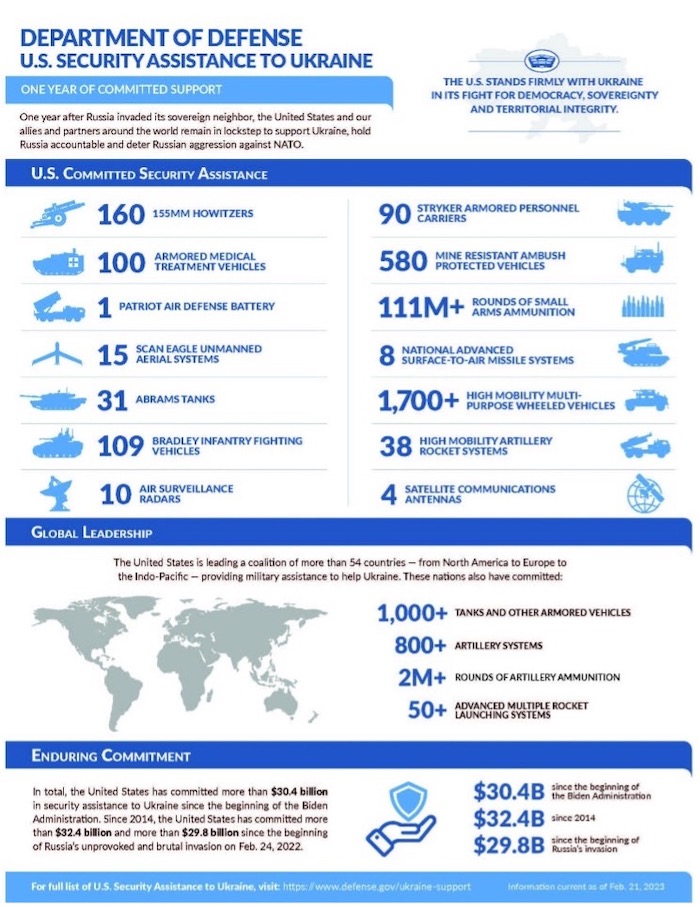
The manual suggests that Russian forces are trying to adapt maneuver forces into smaller and more agile military formations than were employed earlier in the war. The Ukrainian reserve officer noted that this new tactical formation suggests that Russian forces have replaced the defunct battalion tactical group (BTG) with these smaller and more agile maneuver formations. The manual suggests that Russian forces are using T-72 tanks for direct fire support from the rear rather than as integral parts of a combined arms team. The increased reliance on dismounted infantry and the relegation of tanks to fire support from the rear indicates that Russian military leadership is prioritizing protecting main battle tanks over protecting infantry, which is reflective of recent reports of massive equipment losses that Russian armor units sustained over the first year of the war. The manual indicates that the Russian military is resorting to employing a form of simplified combined arms warfare that has likely been pared down to compensate for the overall degradation of Russian manpower and equipment capacity and which is easier for inexperienced and untrained mobilized personnel slotted into such detachments to employ.
The tactics of the assault detachment additionally suggest that the Russian military may be attempting to institutionalize practices used to marginal tactical effect by the Wagner Group in Bakhmut. The Ukrainian reserve officer suggested that this new formation is likely partially influenced by Wagner Group operations around Bakhmut. ISW has previously reported on the fact that Wagner has largely relied on squad-sized frontal assaults, which have decreased the reliance on massed fires as Russian artillery and equipment stocks have dwindled. The Wagner Group’s highly attritional offensive on Bakhmut has failed to gain operationally significant ground, so the institutionalization of elements of Wagner’s tactics will likely further normalize attritional frontal assaults. Such tactics are likely to waste Russian combat power and not effectively counter conventional Ukrainian battalions and brigades. Assault detachments may be able to make tactical gains at cost due to their simplicity but will likely culminate rapidly due to their small size and attritional tactics. Russian forces are unlikely to make operationally significant breakthroughs rapidly with this formation.
Key Takeaways
- Russian officials are promoting an information operation that falsely frames Russia’s war in Ukraine as existential to the continued existence of the Russian Federation.
- Russian officials continue to conduct information operations in an attempt to discourage the Western provision of military aid to Ukraine.
- Ukrainian military officials continue to respond to Western concerns over Ukrainian capabilities and suggest that Ukrainian forces are preparing for a spring counteroffensive in southern Ukraine.
- A reportedly captured Russian military manual suggests that Russian forces are implementing new assault tactics to compensate for the current limitations on combat capability in light of continued offensive failures.
- The manual suggests that Russian forces are trying to adopt smaller and more agile combined arms formations than were employed earlier in the war.
- The tactics of the assault detachment additionally suggest that the Russian military may be attempting to institutionalize tactics used to marginal tactical effect by the Wagner Group in Bakhmut.
- US Central Intelligence Director William Burns stated on February 25 that the CIA is confident that Chinese leadership is considering the provision of lethal equipment to Russia but has not made a final decision or provided lethal aid to Russia.
- Ukrainian officials stated that Russian forces have been concentrating and escalating operations along the Luhansk Oblast front line.
- Russian forces continued to conduct ground attacks northwest of Svatove and near Kreminna.
- Russian forces continued to conduct ground attacks across the Donetsk Oblast front line, and Russian sources widely claimed that Wagner Group forces made territorial gains north of Bakhmut.
- Ukrainian officials reported that Russian forces continue to focus on establishing defensive fortifications in east (left) bank Kherson Oblast and Crimea.
- Russian forces are continuing to expend their already limited stocks of precision munitions.
Russian officials announced that all social support measures will enter into force in occupied territories on March 1.
Intel chief Budanov: The next three months to decide the course of events, Ukrinform reports. “The next three months on the front will be very active and decide the further course of events. The relevant statement was made by Chief of the Main Intelligence Directorate at the Ukrainian Defense Ministry Kyrylo Budanov in an interview with Voice of America.
They will be rather active. Very active and will decide the further course of events. These active hostilities… Indeed, they will take place. There will be attempts from their side and from ours, Budanov told. In his words, this refers not only to eastern Ukraine.
According to Budanov, Russia is not currently ready for a long-term war due to limited resources, although it demonstrates the opposite. They are showing in every way that they are ready there, ‘a war for decades’, but in fact their resources are quite limited. Both in time and in volumes. And they know it very well, Budanov noted.
Budanov also expressed opinion that, in order to turn the war around, Ukraine would need intensified arms supplies, including attack aircraft. Ukraine is now holding talks to obtain not attack aircraft but fighter jets.”
AFU’s first battalion completes training to operate M2 Bradley IFV, Ukrinform reports, citing Ukrainian Defense First Deputy Minister Oleksandr Pavliuk. “The first battalion of the Armed Forces of Ukraine has completed training to operate the M2 Bradley IFV. The Ukrainian military were trained to operate the American IFVs at the US base in Germany, Pavliuk wrote. In his words, the M2 Bradley IFVs are powerful vehicles designed to counteract the Soviet equipment in battles.”
- Consequences and what to do?
Meaning of "Peace Plans" by China and UN for Ukraine and World, European Pravda reports. “On February 24, on the first anniversary of the full-scale war, the world found out about two "peaceful" initiatives. The UN General Assembly adopted the resolution Ukraine and its partners proposed on the principles of a future peaceful settlement. On Friday night, China also presented the previously promised peace settlement plan.
Both documents are surprising. The Ukrainian document has turned out to be much less ambitious than many expected. At the same time, the Chinese "peace plan" has turned out to be better than expected.
On February 23, the UN General Assembly voted for the Ukrainian "peace formula" resolution. The mentioned "formula" is a list of 10 conditions or "10 steps to end the war", which Zelenskyy presented at the G20 summit last November. That plan sounded like an undoubtedly beneficial initiative for Ukraine. It did not have any concessions from the Ukrainian side but had strict requirements and restrictions imposed on Russia, including compensation for damages caused by its aggression; provision of international security guarantees to Ukraine; criminal conviction of the leadership of the Russian Federation for the crime of aggression, etc.
This plan is about the option of victory that Ukraine seeks. So its support at the UN level would be a really powerful achievement. However, there were no grounds for such high expectations. The adopted resolution of the UN General Assembly does not foresee any fundamentally new "victory."
The text, which Ukraine and its partner states agreed upon and registered last week, is acceptable for Ukraine and contains no harmful thesis. In fact, it only repeats the previous decisions of the General Assembly. The document does not include the so-called "peace plan." It is absolutely incorrect to say that it embodies the "10 steps to peace" presented by Zelenskyy last year.
Despite the criticism outlined above, the resolution adopted on February 23 is definitely okay for Ukraine. […] Instead, the importance of the UN General Assembly decision is about something else. It was deliberately formulated as vaguely as possible to get a maximum number of states on the Ukrainian side. It has been achieved. This year's voting has proved that the world is on Ukraine's side.
141 countries, like a year ago, voted for the resolution. However, the votes "against" increased somewhat: seven states opposed the idea. Nicaragua and Mali were added to Russia, North Korea, Belarus, Eritrea, and Syria. Even more interesting was the vote for two amendments to the resolution, which Russia had submitted through its puppet Belarus. China is not on the list of countries that voted for them.
Given that China's position is important for many countries, this will greatly help Ukraine consolidate global support. This state is a permanent member of the UN Security Council and a significant regional and global leader, which is equaled by many states in Asia and Africa. […]
Official Beijing made its document public five hours later [then] the adoption of Ukraine's resolution by the UN Assembly. This in itself has already become an indicative signal. There were suspicions at first that the Chinese authorities would put forward a project alternative to the Ukrainian one, which could significantly reduce the number of votes in its favour.
But the text of the Chinese proposal has added even more positivity. The 12-point paper is not a "peace plan." Instead, it fixes the future positions the Chinese leadership will follow in Russia's war against Ukraine. And Kyiv could stick to a significant part of these positions. It is about the territorial integrity of Ukraine as a basic principle (Crimea is Ukraine!), the need to demilitarise the Zaporizhzhia NPP and stop attacks on any nuclear plants; an absolute ban on using nuclear weapons; support of the "grain corridor."
In addition, there are two important points on which China's position differs from expectations. The first is banning the supply of weapons to the conflict zone. The Chinese top diplomat Wang Yi mentioned it just a week ago. It is not there anymore. Doesn't it mean that China is planning to send weapons?
The second feature is undeniably positive for Ukraine. China proposes gradually moving towards negotiations on the conditions to make a ceasefire possible. Formally, even the Ukrainian peace plan falls under this proposal. Although it is more realistic that China tried to find a scheme that would allow it not to side with Russia or Ukraine.”
Ukraine's economy stabilizes after the shock of war, Reuters reports. “Data from Ukraine's European Business Association - which groups over 1,000 foreign and Ukrainian businesses - showed that by the end of May, 47% of their members had fully restored operations and another 50% were working with some limitations. But then missile attacks began in October, dealing Ukraine a hammer blow. Russia struck at power grids and sub-stations across the country, leading to outages during the freezing winter and hitting the heavy industry hard.
The economy shrank by a third last year, the largest fall since Ukraine's independence from the Soviet Union in 1991. Before Russia's invasion, annual economic output had topped $200 billion. As the war enters its second year with no sign of slowing, the challenges are formidable. Reuters canvassed seven economists whose forecasts for 2023 ranged from a sizeable - though far less dramatic - decline of 5% in the gross domestic product (GDP) to a small expansion.
Access to reliable power will be a major obstacle. While many businesses are finding ways to cope with war, those that cannot run on generators alone will struggle this year, according to the economists, two government officials and executives from two private companies. ArcelorMittal Kryvyi Rih, Ukraine's largest steel mill, said its production was currently at about 25% of pre-war levels amid electricity blackouts.
We see small and medium-sized businesses adapt fairly quickly to power shortages by purchasing generators, batteries, and other equipment, while infrastructure damage remains moderate, said Olena Bilan, chief economist at Dragon Capital investment house, whose forecast was the most negative among the economists surveyed. If this situation persists, the fall in GDP in 2023 will not be as significant as we expect. But our forecast also envisages an end of the war's hot phase at the end of the third quarter of 2023, said Bilan. […] Ukraine's central bank predicts GDP will grow by 0.3% this year, while the economy ministry forecasts 3.2% growth.
By last summer, Ukrainian officials had already started sounding more confident about the country's economy, in particular after an UN-brokered grain export deal. The agreement saved Ukraine's agriculture, which accounted for about 12% of GDP and some 40% of overall exports before the war. As of mid-February, Ukraine's grain exports for the 2022-2023 season - which runs July to June - had fallen 29.3% year-on-year to 29.7 million tonnes.
A massive increase in military spending, including army wages, has also provided a boost to the economy, said Vitaly Vavrishchuk, head of research at ICU investment house. Ukraine spent 1.5 trillion hryvnias ($40.6 billion) on its defence sector in 2022 - equivalent to around one-third of its economic output - according to the National Security Council. That was around five times higher than its planned pre-war defence budget.
Tens of billions of dollars in foreign assistance have poured in, both to help plug the budget deficit and arm Ukrainian forces. But despite the positives, Ukraine is well behind where it was before the war began. And the economic toll is staggering.
The invasion destroyed schools, hospitals, ports, roads and bridges. The Kyiv School of Economics estimated the damage to infrastructure due to the war at $138 billion as of December. Poverty rates have soared and the budget deficit is forecast to hit $38 billion in 2023 following a collapse in tax revenues. The government is depending on Western aid to cover it - most of it from the United States and the European Union.
Ukraine's government took measures that helped to reduce the monthly deficit in 2023 to $3-3.5 billion, which is still a huge figure," Finance Minister Serhiy Marchenko said, noting there was also a need for infrastructure investment to fuel a recovery. […] Between 40% and 60% of the energy sector has been damaged, according to Marchenko, who said at a recent roundtable in February that he could often hear attack drones buzzing above his house or the building of his ministry. […]
The steel sector, a key pillar of the economy, is among the hardest hit. Ukraine was the world's 14th-largest producer of steel before the war. Two leading steel producers, Azovstal and MMK Illicha in Mariupol were destroyed and are officially bankrupt. Those that remain are struggling with power outages. […]
The outlook for some other sectors is more positive. Economy ministry data showed Ukraine imported 669,400 generators last year, including over 300,000 in December alone."
Hans Petter Midttun: The Head of Defence Intelligence of Ukraine (DIU) predicts that the next three months on the front will be very active and decide the further course of events. His statement follows that of Vadym Skibitskyi, a representative of the DIU, stating that the Ukrainian Armed Forces will be ready to launch a counteroffensive this spring to cut Russia’s access to Crimea.
Skibitskyi stressed, however, that several prerequisites must first be met, the supply of Western weapons being one of them. The statement is in line with my assessment last week, stressing that a counteroffensive is not likely to start before all – or most of – the prerequisites are in place.
The ground must allow for Cross Country Mobility (CCM). The pledged equipment must have been delivered. New units built around the western tanks and infantry fighting vehicles must have been established, trained, exercised, and tested. It must have sufficient long-range fire, artillery, main battle tanks, and armoured vehicles to exploit breaches in the frontline while keeping sufficient reserves to handle setbacks.
Ukraine must have sufficient mine-clearing capacity to enable a decisive breakthrough across established minefields.
It must have sufficient ammunition to suppress Russian forces during both the initial assault as well as to sustain the ensuing surge. It must have sufficient air defence to both protect the ground forces as well as its cities and critical infrastructure. This is, unfortunately, presently not the case. Some of the pledged air defence systems are still under production for delivery in the years to come.
It must be able to close the sky and provide combat support from the air. Ukraine must not least, be able to prepare the battlefield, including destroying command and control nodes, logistics, ground lines of communications, and concentrations of manpower and equipment. Today, many of these remain out of reach as Russia has adapted to the threat from HIMARS.
Neither the US nor NATO would ever consider starting an offensive against dug-in and prepared ground forces, supported by long-range fire, combat aircraft and attack helicopters without being able to project overwhelming force in all 3 dimensions.
Most of the prerequisites will, consequently, not be in place before summer. Some – including long-range fire, combat aircraft and sheer numbers – might not be in place this year.
President Biden has argued that Ukraine doesn’t need F-16, while Ukraine continues to ask for them. That was one of the topics during yesterday’s talk between General Zaluzhnyi, Commander-in-Chief of the Ukrainian Armed Forces, and General Milley, Chairman of the US Joint Chiefs of Staff. The former stressed the need to strengthen Ukraine’s air defence capabilities, through the supply of F16 multi-role fighter aircraft.
Some of the requirements are still being denied. If – or rather when – they agree to deliver long-range fire and aircraft – Ukraine will need months to qualify the operators and integrate the system into its joint forces. The inflow of weapons remains incremental and slow and continues to limit Ukraine’s ability to engage Russian forces. Some like air defence, are awaiting production and will not arrive for years.
Still, Ukraine might attempt a counteroffensive before summer for lack of alternatives as time favours Russia.
According to British Intelligence, Russia has recently changed its approach and is presently primarily seeking to degrade the Ukrainian military, rather than being focused on seizing substantial new territory. It is pursuing a long-term operation where they hope that Russia’s advantages in population and resources will eventually exhaust Ukraine.
Additionally, as Russia is learning from its past mistakes and hard-won lessons learned, it is adapting its tactics to further reduce Ukrainian military potential.
According to ISW:
A reportedly captured Russian military manual suggests that Russian forces are implementing new assault tactics to compensate for the current limitations on combat capability in light of continued offensive failures. The manual suggests that Russian forces are trying to adopt smaller and more agile combined arms formations than were employed earlier in the war. The tactics of the assault detachment additionally suggest that the Russian military may be attempting to institutionalize tactics used to marginal tactical effect by the Wagner Group in Bakhmut.
Russia is also operating Shahed UAVs together with A-50 MAINSTAY Airborne Early Warning (AEW) System to both exhaust the Ukrainian air defence system and identify their locations for follow-on attacks.
While Ukraine’s active defence is inflicting tremendous losses of both manpower and equipment on Russian forces, the UAF is also suffering. While Russia experiences nearly twice as many casualties– and the number of severely wounded might are several times higher – the cost to Ukraine is still extremely high.
Ukraine, therefore, needs to change the dynamics on the battlefield. Unfortunately, the West still insist on limiting its freedom of action at the cost of civil society and its armed forces. Ironically, the slow and incremental defence support is also inflicting damage on Europe as China is considering doing what the West has done half-heartedly:
Change the military balance.
DIU believes the spring-summer campaign will be extremely difficult. I fear their assessment is correct.

